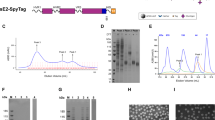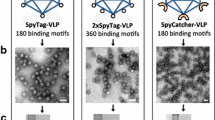Abstract
Immunoglobulin E (IgE) plays a central role in type I hypersensitivity including allergy and asthma. Novel treatment strategy envisages development of a therapeutic vaccine designed to elicit autologous blocking antibodies against the IgE. We sought to develop an IgE-epitope antigen that induces antibodies against a receptor-contacting epitope on human IgE molecule. We designed the VLP immunogens which utilize hepatitis B virus core protein (HBcAg) as a carrier, and present arrays of the receptor-contacting epitopes of the human IgE on their surfaces. FG loop from the IgE domain Cε3 was engineered into the HBcAg. Two constructs explore a well-established approach of insertion into a main immunodominant region of the HBcAg. Third construct is different in that the carrier is produced in a form of an assembly of two polypeptide chains which upon expression remain associated in a stable VLP-forming subunit (SplitCore technology). No VLPs were isolated from E.coli expressing the IgE-epitope antigens with contiguous sequences. On the contrary, the SplitCore antigen carrying the FG loop efficiently formed the VLPs. Immunization of mice with the VLPs presenting receptor-contacting epitope of the IgE elicited antibodies recognizing the human IgE in ELISA.








Similar content being viewed by others
References
Castelli, M., Cappelletti, F., Diotti, R. A., Sautto, G., Criscuolo, E., Dal Peraro, M., & Clementi, N. (2013). Peptide-based vaccinology: Experimental and computational approaches to target hypervariable viruses through the fine characterization of protective epitopes recognized by monoclonal antibodies and the identification of T-cell-activating peptides. Clinical and Developmental Immunology, 2013, 521231.
Gershoni, J. M., Roitburd-Berman, A., Siman-Tov, D. D., Tarnovitski, F. N., & Weiss, Y. (2007). Epitope mapping: The first step in developing epitope-based vaccines. BioDrugs, 21, 145–156.
Toussaint, N. C., & Kohlbacher, O. (2009). Towards in silico design of epitope-based vaccines. Expert Opinion on Drug Discovery, 4, 1047–1060.
Crisci, E., Barcena, J., & Montoya, M. (2012). Virus-like particles: The new frontier of vaccines for animal viral infections. Veterinary Immunology and Immunopathology, 148, 211–225.
Kushnir, N., Streatfield, S. J., & Yusibov, V. (2012). Virus-like particles as a highly efficient vaccine platform: Diversity of targets and production systems and advances in clinical development. Vaccine, 31, 58–83.
Rivera-Hernandez, T., Hartas, J., Wu, Y., Chuan, Y. P., Lua, L. H., Good, M., et al. (2013). Self-adjuvanting modular virus-like particles for mucosal vaccination against group A streptococcus (GAS). Vaccine, 31, 1950–1955.
Brun, A., Barcena, J., Blanco, E., Borrego, B., Dory, D., Escribano, J. M., et al. (2011). Current strategies for subunit and genetic viral veterinary vaccine development. Virus Research, 157, 1–12.
Fehr, T., Skrastina, D., Pumpens, P., & Zinkernagel, R. M. (1998). T-cell-independent type I antibody response against B-cell epitopes expressed repetitively on recombinant virus particles. Proceedings of the National Academy of Sciences of the USA, 95, 9477–9481.
Chackerian, B., Lowy, D. R., & Schiller, J. T. (1999). Induction of autoantibodies to mouse CCR5 with recombinant papillomavirus particles. Proceedings of the National Academy of Sciences of the USA, 96, 2373–2378.
Chackerian, B. (2010). Virus-like particle based vaccines for Alzheimer disease. Human Vaccines, 6, 926–930.
Chackerian, B., Lowy, D. R., & Schiller, J. T. (2001). Conjugation of a self-antigen to papillomavirus-like particles allows for efficient induction of protective autoantibodies. Journal of Clinical Investigation, 108, 415–423.
Guan, Q., Ma, Y., Aboud, L., Weiss, C. R., Qing, G., Warrington, R. J., & Peng, Z. (2012). Targeting IL-23 by employing a p40 peptide-based vaccine ameliorates murine allergic skin and airway inflammation. Clinical and Experimental Allergy, 42, 1397–1405.
Ma, Y., Hayglass, K. T., Becker, A. B., Halayko, A. J., Basu, S., Simons, F. E., & Peng, Z. (2007). Novel cytokine peptide-based vaccines: An interleukin-4 vaccine suppresses airway allergic responses in mice. Allergy, 62, 675–682.
Röhn, T. A., Jennings, G. T., Hernandez, M., Grest, P., Beck, M., Zou, Y., et al. (2006). Vaccination against IL-17 suppresses autoimmune arthritis and encephalomyelitis. European Journal of Immunology, 36, 2857–2867.
Spohn, G., Keller, I., Beck, M., Grest, P., Jennings, G. T., & Bachmann, M. F. (2008). Active immunization with IL-1 displayed on virus-like particles protects from autoimmune arthritis. European Journal of Immunology, 38, 877–887.
Zhou, G., Ma, Y., Jia, P., Guan, Q., Uzonna, J. E., & Peng, Z. (2010). Enhancement of IL-10 bioactivity using an IL-10 peptide-based vaccine exacerbates Leishmania major infection and improves airway inflammation in mice. Vaccine, 28, 1838–1846.
Whitacre, D. C., Lee, B. O., & Milich, D. R. (2009). Use of hepadnavirus core proteins as vaccine platforms. Expert Review Vaccines, 8, 1565–1573.
Crowther, R. A., Kiselev, N. A., Bottcher, B., Berriman, J. A., Borisova, G. P., Ose, V., & Pumpens, P. (1994). Three-dimensional structure of hepatitis B virus core particles determined by electron cryomicroscopy. Cell, 77, 943–950.
Pumpens, P., & Grens, E. (2001). HBV core particles as a carrier for B-cell/T-cell epitopes. Intervirology, 44, 98–114.
Roose, K., De Baets, S., Schepens, B., & Saelens, X. (2013). Hepatitis B core-based virus-like particles to present heterologous epitopes. Expert Review Vaccines, 12, 183–198.
Chen, S. S., Barankiewicz, T., Yang, Y. M., Zanetti, M., & Hill, P. (2008). Protection of IgE-mediated allergic sensitization by active immunization with IgE loops constrained in GFP protein scaffold. Journal of Immunological Methods, 333, 10–23.
Lee, J. (2014). Successful prevention of recurrent anaphylactic events with anti-immunoglobulin E therapy. Asia Pacific Allergy, 4, 126–128.
Peng, Z., Liu, Q., Wang, Q., Rector, E., Ma, Y., & Warrington, R. (2007). Novel IgE peptide-based vaccine prevents the increase of IgE and down-regulates elevated IgE in rodents. Clinical and Experimental Allergy, 37, 1040–1048.
Wang, C. Y., Walfield, A. M., Fang, X., Hammerberg, B., Ye, J., Li, M. L., et al. (2003). Synthetic IgE peptide vaccine for immunotherapy of allergy. Vaccine, 21, 1580–1590.
Liu, S., Tobias, R., McClure, S., Styba, G., Shi, Q., & Jackowski, G. (1997). Removal of endotoxin from recombinant protein preparations. Clinical Biochemistry, 30, 455–463.
Garman, S. C., Wurzburg, B. A., Tarchevskaya, S. S., Kinet, J. P., & Jardetzky, T. S. (2000). Structure of the Fc fragment of human IgE bound to its high-affinity receptor Fc epsilonRI alpha. Nature, 406, 259–266.
Walker, A., Skamel, C., & Nassal, M. (2011). SplitCore: An exceptionally versatile viral nanoparticle for native whole protein display regardless of 3D structure. Scientific Reports, 1, 5.
Holdom, M. D., Davies, A. M., Nettleship, J. E., Bagby, S. C., Dhaliwal, B., Girardi, E., et al. (2011). Conformational changes in IgE contribute to its uniquely slow dissociation rate from receptor FcɛRI. Nature Structural & Molecular Biology, 18, 571–576.
Wan, T., Beavil, R. L., Fabiane, S. M., Beavil, A. J., Sohi, M. K., Keown, M., et al. (2002). The crystal structure of IgE Fc reveals an asymmetrically bent conformation. Nature Immunology, 3, 681–686.
Qiao, C. X., Lv, M., Guo, L. M., Yu, M., Li, Y., Lin, Z., et al. (2009). Inhibition of IgE activity to bind its high affinity receptor (FcεRIα) by mouse anti-IgE Cε3∼4 monoclonal antibody (QME5). International Journal of Biomedical Sciences, 5, 336–344.
Ye, H., Housden, J. E., Hunter, M., Sabban, S., & Helm, B. A. (2014). Identification of amino acid residues involved in the interaction of canine IgE with canine and human FcεRIα. Molecular Immunology, 57, 111–118.
Kim, B., Eggel, A., Tarchevskaya, S. S., Vogel, M., Prinz, H., & Jardetzky, T. S. (2012). Accelerated disassembly of IgE-receptor complexes by a disruptive macromolecular inhibitor. Nature, 491, 613–617.
Zheng, L., Li, B., Qian, W., Zhao, L., Cao, Z., Shi, S., et al. (2008). Fine epitope mapping of humanized anti-IgE monoclonal antibody omalizumab. Biochemical and Biophysical Research Communications, 375, 619–622.
Wang, C. Y., & Walfield, A. M. (2005). Site-specific peptide vaccines for immunotherapy and immunization against chronic diseases, cancer, infectious diseases, and for veterinary applications. Vaccine, 23, 2049–2056.
Klamp, T., Schumacher, J., Huber, G., Kühne, C., Meissner, U., Selmi, A., et al. (2011). Highly specific auto-antibodies against claudin-18 isoform 2 induced by a chimeric HBcAg virus-like particle vaccine kill tumor cells and inhibit the growth of lung metastases. Cancer Research, 71, 516–527.
Acknowledgments
This work was supported by Grant #0112RK00352 “Study of immunogenicity of virus-like particles carrying epitopes of human immunoglobulin E” from the Ministry of Education and Science (MES) of the Republic of Kazakhstan.
Conflict of interest
The authors declare that there are no conflicts of interest.
Author information
Authors and Affiliations
Corresponding author
Rights and permissions
About this article
Cite this article
Baltabekova, A.Z., Shagyrova, Z.S., Kamzina, A.S. et al. SplitCore Technology Allows Efficient Production of Virus-Like Particles Presenting a Receptor-Contacting Epitope of Human IgE. Mol Biotechnol 57, 746–755 (2015). https://doi.org/10.1007/s12033-015-9867-0
Published:
Issue Date:
DOI: https://doi.org/10.1007/s12033-015-9867-0




